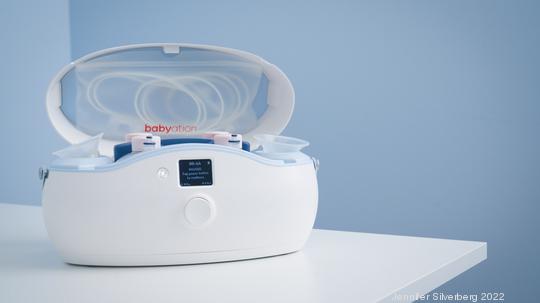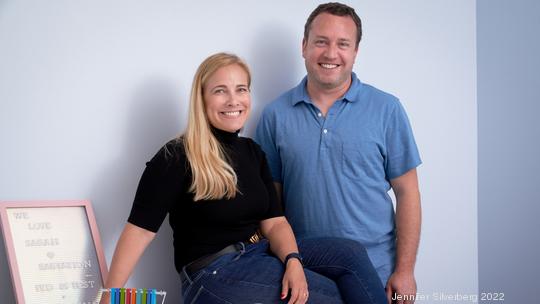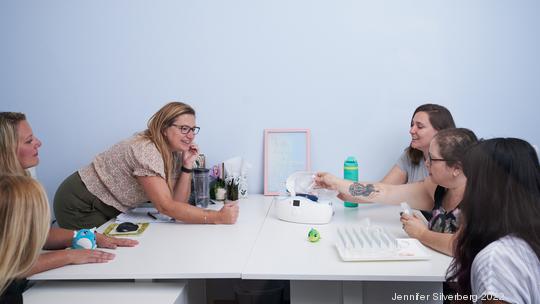
Samantha Rudolph knew one day she wanted to be a mom. However, when she read an article in The New York Times in 2014 titled, “Shouldn’t the Breast Pump Be as Elegant as an iPhone and as Quiet as a Prius by Now?” she saw her future flash before her eyes — and she didn’t like what she saw.
“I turned to my husband, Jared Miller, woke him up and climbed up on my soapbox,” says Rudolph. “Jared is a very good engineer, and he opened up one eye and said, ‘Oh, breast pumps aren’t that complicated; I can build one.’”
But building a breast pump was not necessarily part of this couple’s big picture plan, with successful jobs at ESPN (Rudolph) and the engineering side of television (Miller). Plus, they figured that surely someone else would see the need and step up to the plate.
“We thought our idea of quiet, discreet and smart was so obvious that someone else was going to do it,” says Rudolph. “But after six months we said, ‘OK, let’s dip our toes a little further.’”
That dip turned into a deep dive. Rudolph and Miller founded Babyation, a startup that creates products for moms, beginning with a revolutionary breast pump.

“We organized the company, filed a provisional patent and then started getting grant funding,” says Rudolph. “Then we received an Arch Grant.”
That $50,000 Arch Grant ultimately brought the then-Connecticut-based couple back to Rudolph’s hometown of St. Louis in the fall of 2015 to further build Babyation.
“If you want to breastfeed your baby, but you need to be away from that baby for more than a few hours at a time, a breast pump becomes a necessity,” says Rudolph. “It’s not an option. It’s not a luxury. It’s a supply and demand thing. So, to see dairy cows have newer technology than human women, and still do in many cases – that’s absurd. And that sparked a lot of outrage.”
While it took six years to get the Babyation breast pump on the market, its first review started things off with a bang.
“I vividly remember someone calling me, and she said, ‘Hey, did you see the review?’” says Rudolph. “I said, ‘no,’ and she read it to me. The reviewer had said she tried 16 pumps before ours, and ours was the best. I just started crying because that was six years of our lives that went into one person’s review. That meant more than I can ever say.”
And the rave reviews have kept coming – including TIME naming the product one of the best inventions of 2022, thanks to the features that make Babyation’s pump an anomaly within the industry.

“We envisioned the breast-pumping process from start to finish,” says Rudolph.
Thinking through every part of the pumping process and improving it is key, since it’s estimated that women who breastfeed their infants for the first year spend 1,800 hours doing so — just shy of the 1,960 hours a year required of a 40-hour workweek job with three weeks of paid vacation.
The accompanying app is Rudolph’s favorite part of the pump, because it helps eliminate some of the mental load of breastfeeding with its history, inventory, tracking and control tools. While these features may not seem remarkable, they are a significant departure from the typical pumping process. Women navigate their postpartum return to work with many challenges — and anything that makes that transition easier (such as a pump quiet enough that you can use it during a Zoom call) allows for more equity in the workplace.
Rudolph and Miller were not originally planning to manufacture their product in St. Louis, but doing so from their facility in Maryland Heights has turned out to be a boon.
“In a lot of ways, we’re immune from some of the supply chain and manufacturing capacity challenges because we’re in control of our own destiny,” Rudolph says.
Her number one tip to anyone starting a company is to identify their reason for doing so.
“There are going to be good days and there are going to be bad days … you have to know why you’re pouring your blood, sweat and tears into it. And, for us, it’s always been the moms. If we weren’t truly, in our way, fighting to make their lives better, I don’t think this company would still be here.”
STLMade, an initiative of Greater St. Louis Inc., shines a light on people and ideas that are moving the region forward and contributing to make this a place where you can start something, you can get the support to stand out, and you can stay and make St. Louis yours.



